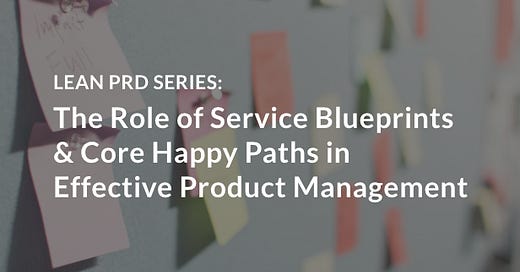The Role of Service Blueprints and Core Happy Paths in Effective Product Management
Utilizing service blueprints and establishing core happy paths are instrumental in achieving this goal. Let's explore how these tools can enhance product vision & streamline development
Defining the Product Goal
Use Service Blueprints
A service blueprint is an intricate visual map that outlines the user’s journey with a product, from initial engagement through to the end of the use cycle. It captures not only user interactions but also the back-end processes that support these experiences throughout the entire journey. The use of service blueprints facilitates a holistic view of the product’s operation, and can help highlight areas of strength, areas of improvement and any missed opportunities.
Benefits of Service Blueprints
Implementing service blueprints brings teams onto the same page, enhancing understanding and alignment regarding the product’s context and user interactions. This collective insight is crucial for developing a cohesive and user-friendly product.
Establishing Core Happy Paths/Flows
Visual Wireframes and User Flow Steps
By focusing on core happy paths, or the optimal user journey scenarios, product teams can concentrate on delivering the highest value aspects of the user experience. This method combines visual wireframes with user flow steps, providing a clear roadmap for achieving the product's goals.
Impact on Development
Prioritizing these core flows enables teams to allocate their efforts more efficiently, bypassing less critical features to focus on those that genuinely enhance the user experience. This approach not only saves time and resources but also ensures that the development process remains centered on user satisfaction.
Strategic Feature Prioritization
Categorizing Features
Dividing features into essential and non-essential categories helps teams focus on developing the most impactful aspects of the product first. This prioritization ensures that resources are used effectively, and that the product can quickly reach a market-ready state.
💡Tip: Use a Prioritization method like MoSCow
By categorizing features into 'Must Have', 'Should Have', ‘Could Have', and 'Won’t Have', product managers can focus resources on what truly matters for the initial launch, ensuring that development efforts are both efficient and impactful.
Efficient Resource Allocation
Once the team has a better understanding of which features are crucial for the product's success, they can now better manage stakeholder expectations and align their development efforts with the overarching product strategy.
Incorporating User Feedback
The Iterative Approach
One of the pillars of successful product development is the iterative incorporation of user feedback. Engaging with users throughout the development process allows teams to make informed adjustments, ensuring the final product meets real user needs and preferences.
Adapting to Feedback
Seamless integration of user insights into the development process is essential for creating a product that not only meets but exceeds user expectations. This user-centered approach fosters a deeper connection between the product and its intended audience.
Conclusion
The strategic use of service blueprints and core happy paths significantly enhances the product planning and development process. By providing a clear vision and focusing on what truly matters to users, product managers can steer their teams toward the creation of impactful, user-centric products. As we navigate the complexities of product development, these tools offer a pathway to clarity, alignment, and success, ensuring that the end product not only meets but surpasses user expectations.
💡 Looking ahead!
Our series will continue to demystify the intricacies of effective product planning. Future articles will delve into the practical application of tools like Service Blueprints, Wireframes, and User Flows. These tools are essential for defining the “What” section of the Lean PRD, offering a clearer understanding and alignment within the team.
We’ll explore how to use these tools to detail the user experience, streamline communication, and ensure that every member of the team shares a unified vision for the product. This upcoming content is designed to equip you with the knowledge and skills to further refine your product development process, making it more efficient and aligned with your objectives.




